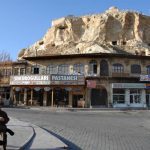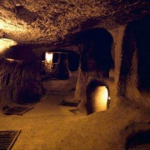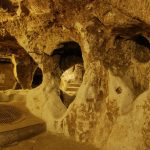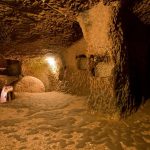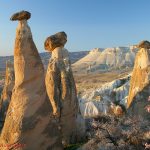Hacibektas Museum Nevsehir Cappadocia – Chapter 2,
Mescid: At the far end of the Second Courtyard near the Kitchen is a mescid with a single dome and minaret, which was built by the Ottoman Sultan Mahmud II. The mescid is open for worship. The Sixes Gate leads from the Second to the Third Courtyard, called the Saints Courtyard.
Third Courtyard: On the right side of the Third Courtyard is the grave of Dedebaba and the Balim Sultan tomb.On the opposite side is the Haci Bektas-i Veli Tomb.
A three arched exedra leads to the Tomb. To the right and left of the exedra are the sarcophagi of the Bektashi Fathers who rendered service to the Dargah. From the exedra, a marble portal called the White Gate leads into a dark corridor. On the right side of the corridor is a small vaulted domed room called the Red Cell or Novitiate. This room is considered to be the heart of the Dargah and said to be the cell of Haci Bektas. A second door leads from the corridor to the Hall which has a domed roof and ‘was built during the reign of the Ottoman Sultan Suleyman the Law Giver. The cases in the hall contain objects used in the Dargah by the Bektashi dervishes such as tablets, candlesticks, and lamps. In the east wall of this hall is the Supplication Window, and to the south and north are the crowned sarcophagi of sheiks and other high ranking members of the order.
Huzur-u Pir and Tomb: On the right side of the hall is the Tomb of Haci Bektas-i Veli. The carved marble door which leads into the Tomb is called the Huzur-u Pir. The tomb is of typical classic Seljuk period style and contains the sarcophagus of Haci Bektas which is covered with an embroidered cloth.
Balim Sultan Tomb: Hizir Bal who died in 1516 was the second great leader of the Bektasi order who made great contributions towards its organization. The tomb has a classic pyramid shaped dome and is situated on the south side of the Third Courtyard. In front of it is a three arched exedra from which a small door leads to the room where the sarcophagus of Balla! Sultan is situated. A second sarcophagus belongs to the brother of Hizir Bal, Kalender Mursel Bali who died in 1544. Candlesticks are exhibited in the tomb.
Objects from Karacahoyuk: Findings from excavations at Suluca Karahoyuk near Hacibektas which were conducted by Prof. K. Balkan are also exhibited and stored in the Hacibektas Museum.




















































































































